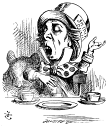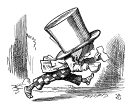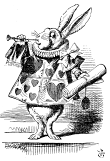Search us!
Search The Word Detective and our family of websites:
This is the easiest way to find a column on a particular word or phrase.
To search for a specific phrase, put it between quotation marks. (note: JavaScript must be turned on in your browser to view results.)
Ask a Question! Puzzled by Posh?
Confounded by Cattycorner?
Baffled by Balderdash?
Flummoxed by Flabbergast?
Perplexed by Pandemonium?
Nonplussed by... Nonplussed?
Annoyed by Alliteration?

Don't be shy!
Send in your question!
Columns from 1995 to 2006 are slowly being added to the above archives. For the moment, they can best be found by using the Search box at the top of this column.
 If you would like to be notified when each monthly update is posted here, sign up for our free email notification list.
If you would like to be notified when each monthly update is posted here, sign up for our free email notification list.
Trivia
All contents herein (except the illustrations, which are in the public domain) are Copyright © 1995-2020 Evan Morris & Kathy Wollard. Reproduction without written permission is prohibited, with the exception that teachers in public schools may duplicate and distribute the material here for classroom use.
Any typos found are yours to keep.
And remember, kids,
Semper Ubi Sub Ubi
|
Remember, kids, “Has been” will always beat “Never was.”
Dear Word Detective: I recently heard a female “celebrity” being described as a “washed-up” Playboy bunny. I’m curious for where the “washed up” usage comes from; I’m guessing it’s got more to do with flotsam and jetsam appearing on the beach than good bodily hygiene. — Chris, Kansas City.
That’s a good question, which makes me wonder why I didn’t answer it when you sent it in 18 months ago. Mea culpa. The truth is that I’ve been staring out the window at squirrels for the past few years (it’s cheaper than cable), and I’m afraid I’ve adopted their habit of burying especially tasty treasures for later use. This may also explain why my sock drawer is stuffed with oatmeal cookies.
“Wash” is one of those little big words, the small words that, by virtue of meaning something central to everyday life, have acquired an apparently endless entourage of extended and derivative meanings. “Wash” first appeared in Old English, in the form “waescan” or “wascan,” derived from Germanic forms that all point back to the Germanic root word “wat.” That “wat,” by the way, also gave us our English word “water.” In English, the most basic sense of “to wash” has been simply “to cleanse by means of water.” Fun fact: in Old English “waescan” was used only when referring to clothes; if you were washing dishes or your own body, you used “thwean.” Time travelers take note.
In addition to all the literal senses of “wash,” English employs the word in a variety of idioms and slang phrases. To “wash one’s dirty linen in public,” a French proverb popularized by Napoleon, means to expose one’s personal affairs to public scrutiny. When we say that something will “come out in the wash,” an idiom dating back to about 1900, we mean that either the truth will be revealed (i.e., dirt washed away) or that a situation will be made right (i.e., a stain removed). If an assertion or alibi won’t stand scrutiny, we say “it won’t wash,” meaning that it will prove to be untrue or unacceptable in the metaphorical “wash” of close examination.
“Wash up,” of which “washed up” is an adjectival form, does indeed mean “to be deposited on shore by the action of waves or the tide,” as “flotsam” and “jetsam” frequently are. (“Flotsam,” strictly speaking, means floating items (cargo, tools, etc.) washed overboard from a ship, possibly as it sinks, while “jetsam” means items deliberately thrown overboard (jettisoned), sometimes in order to avoid sinking.) “Washed up” in this “what’s that on the beach” sense would make a vivid, if somewhat grisly, slang metaphor for “worn out” or “has-been.”
Fortunately, the origin of “washed up” in the “brilliant career definitely over” sense is much more benign. “Wash up” has been used as slang meaning “to finish, to end” since the 1920s. The original sense seems to have been “washing up,” cleaning one’s hands, face, etc., after completing a job, and the earliest citations indicate that it first became popular in the theater (“[Stage slang.] Washed up, all through for the night,” NY Times, 1923). But another citation, this one from the NY World in 1925, indicates that “wash up” was also used in the sense of “to get rid of” or “to deep six” an unpromising performer (“‘That guy might be all right if he washed up [washed, cleaned himself],’ commented Buck… Just then the stage manager called out: ‘What will I do with this act, Mr. Ziegfeld?’ ‘Wash up him and the bird,’ said Flo [Ziegfeld] and that was the last of the Italian and his trained canary.”). So a “washed up” act was one that had been “washed up” and sent home.
“Wash up” has occasionally been used in a positive “finish” or “complete” sense (“‘I had an idea,’ he explained.? ‘Just came to me, riding back. I think I know how I can wash it up.’? He would write it now — tonight!” 1929). But “washed up” (or “all washed up”) has pretty consistently meant “worn out, finished, ruined,” whether it was applied to a personal relationship or the career of someone considered, perhaps a bit prematurely, a has-been (“Once he was the most underestimated man in American politics — a washed-up movie star, it was said, who was too old, too simple and too far right to be President,” Newsweek, 1980).
Whatever it was, it was a really good whatever it was.
Dear Word Detective: I often reply “Jim Dandy” when asked how I’m feeling. Was Mr. Dandy a real or fictional gentleman, and if so, was he known for his contented nature? Or have I been using his name in vain? — Regards from Jane Dandy.
You too, eh? I generally reply to the question with either “fine” or “peachy.” It’s some weird compulsion, probably based in all that positive thinking folderol we were fed as kids. Then again, maybe you really do feel “Jim Dandy” most of the time, in which case you have some ‘splainin to do. I watch enough TV commercials to know we all feel awful and need at least nineteen prescription drugs just to get out of bed every day. In fact, I don’t think you’re as “Jim Dandy” as you think you are. I think you have Chronic Pervasive Health and Contentment Syndrome (CPHCS), a serious disorder I just invented, for which an appropriate treatment will no doubt be marketed shortly. You’ll know you’ve beaten CPHCS when you think you have 37 other diseases.
“Jim Dandy” is interesting in several respects. First, it’s a noun as well as an adjective. It’s also apparently a US invention, first appearing in print, as far as we know, in the Courier-Journal newspaper in Louisville, Kentucky in 1887 (“Dear Sir: Though a stranger to you (yet a Democrat), let me say you are a ‘Jim Dandy'”). In this noun form, “Jim Dandy” meant simply “an excellent person or thing.” The first verified adjectival use of “Jim Dandy” appeared in a Chicago publication one year later (“George C. Ball came upon the floor yesterday arrayed in a jim-dandy suit of clothes.”). As an adjective it’s used to mean “strikingly fine” or “excellent.” The use of “Jim Dandy” as a noun is rare today, but the adjectival form is obviously alive and well, and usually appears in print lower-case and hyphenated.
As to whether “Jim Dandy” ever referred to an actual person, the jury is still out (it’s hard to prove a negative), but the consensus among etymologists seems to be “probably not.” That doesn’t mean that the term just dropped out of thin air, however. There was a popular minstrel song back in the 1840s called “Dandy Jim of Caroline” (words and music by Silas Sexton Steel and J. Richard Myers, respectively) which may have planted the seed of “Jim Dandy” in the public consciousness. The song, written in a mock African-American dialect, tells the story of a “dandy” young man who woos and wins a young woman named Dinah and goes on to have “eight or nine young Dandy Jims of Caroline.”
“Dandy” as a noun dates back to the late 18th century, when it first appeared in England meaning a young man who devotes excessive attention to fashionable dress and grooming, otherwise known as a “fop.” The origin of word “dandy” itself is a mystery, but it may be a shortened form of the 17th century term “Jack-a-dandy,” which meant “a conceited little man.” It may also be significant that “Dandy” is a familiar form of the name “Andrew” in Scotland.
The historical existence of the term “dandy” and an inexplicably popular 19th century song titled “Dandy Jim of Caroline” are probably the closest we’ll get to an explanation of “Jim Dandy!” as a positive personal status update. But, in an interesting sidelight, etymologist Gerald Cohen has uncovered what seems to have been the avenue by which the term “Jim Dandy” was widely popularized. Fittingly for an American colloquialism, it was baseball. Although the earliest instance of the term found so far in print is in a non-baseball context, according to Cohen, sports reporters instantly fell in love with in the term (“The Giants gave the local patrons of the game a couple of surprises during the past week, and whereas on Wednesday night they were proclaimed ‘Jim Dandy’ players, they were on Thursday declared to be ‘no good,'” The World (New York), June 19, 1887), and used it frequently.
We call it “enhancing the reading experience.”
Dear Word Detective: What is the best connection you can dream up between “lying” and “drawing a long bow”? Is it related to what I call “adding to the truth”? I used to see it as related to playing on a violin but I could never get anywhere with that. — Ken in Alaska.
Ah, yes, the violin, the most deceptive of musical instruments. So fragile and delicate, yet so shamelessly manipulative. The mere sound of swelling violins on a film soundtrack has long been recognized as a signal of impending hokum and hornswoggling, and violins are, of course, anathema to cats. No instrument, save the harmonica, is so redolent of deceit and perfidy. And it doesn’t help that the things make anyone playing one look like Richard Nixon in his worst “I am not a crook” moment. The furrowed brow, the trembling jowls; like a bulldog eating an end table.
Thank heavens that violins have nothing to do with the phrase “to draw a long bow,” eh? It’s an idiom dating back to at least the 1660s meaning “to exaggerate; to tell tall tales,” so it’s both more and less than simply “lying.” There’s something about the topic of exaggeration, incidentally, that brings out the colorful phrases. The Oxford English Dictionary (OED) Historical Thesaurus lists such synonyms for “draw the long bow” as “to go beyond the moon” (circa 1430), “to turn every goose into a swan” (1621), “to overegg the pudding” (1845), and, of course, “to lay it on with a trowel” (which, a bit surprisingly, dates back to around 1616).
The “long bow” in the phrase is the English “longbow,” a fearsome weapon which dominated European warfare from its rise in the 13th century until the widespread adoption of gunpowder in the 16th century. The longbow was indeed “long,” usually roughly the height of a typical archer, made of English yew wood, and required a hefty 90-110 pounds of force to “draw” in order to fire an arrow. Using a longbow required long training as well as development of the physical strength required to use one. But in trained hands, the longbow was capable of punching an arrow through Medieval metal armor at great distances, and the English victory over the French at the Battle of Agincourt in 1415 was both the most famous victory and the high water mark of the longbow.
By the way, to “draw” (pull back) the bowstring on a bow employs “draw” (from the Old English “dragan,” to pull or drag, also related to “drag”) in its original sense of “to pull.” When an artist “draws” a picture, the pencil, etc., is “pulled” across the paper. “Draw” in the archery sense dates to the early 14th century; the “create a picture” sense arose around 1200.
As the “killer app” of Medieval warfare, the longbow inspired a large body of popular lore about the extraordinary feats of its users. English folk legends centering on Robin Hood, for instance, depict him as a master of the longbow and an almost supernaturally gifted marksman, easily capable of hitting tiny targets at enormous distances. The longbow also featured in a number of popular sayings still used today. “To have many strings to one’s bow,” a reference to archers carrying at least one spare bowstring into battle, means to have several alternatives or resources available (“Miss Bertram … might be said to have two strings to her bow,” Jane Austen, 1814). “To shoot another’s bow” means to practice an art or skill not your own, and “the bent of one’s bow” refers to a person’s character or inclination (“I have the bent of his bowe, that I know,” 1562).
Given the centrality of the longbow to English culture and the number of legends and “tall tales” that sprang up about the near-magical skills of its users, it’s not surprising that someone relaying an exaggeration or fantastic story would be said to be “drawing a long bow” as if relating Robin Hood-esque feats of derring-do. Appearing first in print in 1668 (“There came to us several Tradesmen; the first of them a Poor Rogue that made profession of drawing the long Bow”), to “draw the long bow” is the equivalent of telling the traditional “fish story” about the huge catch that got away. It’s not really lying, because no one within earshot truly believes it’s true.
|
Makes a great gift! Click cover for more.  
400+ pages of science questions answered and explained for kids -- and adults!
FROM ALTOIDS TO ZIMA, by Evan Morris
 
|


 can be found
can be found 




Recent Comments